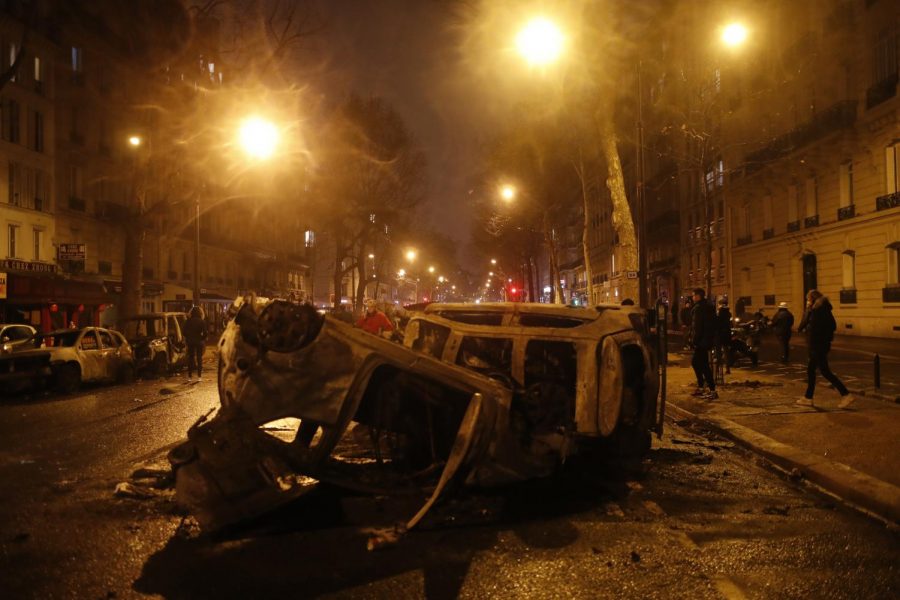The “City of Lights” in flames from civil unrest
Hundreds arrested in Paris city protests, many wounded
Charred cars are pictured after a demonstration Saturday, Dec.1, 2018 in Paris. A protest against rising taxes and the high cost of living turned into a riot Saturday in Paris as police fired tear gas and water cannon in street battles with activists wearing the fluorescent yellow vests of a new movement.
December 12, 2018
Over the past weekend, the city of Paris saw a violent protest that the city hasn’t seen in over years. Demonstrators wore yellow-vests, or gilets juanes, and protested a recent decision made by Emmanuel Macron, the president of France. What resulted was millions of dollars in destruction in Paris, more than 100 injuries, and more than 300 arrests.
The French Interior Ministry estimated that nearly 136,000 protestors were in Paris over the weekend, in addition to the 280,000 protestors over the previous weeks. Originally, the yellow vest protesters were people from rural areas who have to drive long distances as part of their daily life. The protests began in the French provinces but spread into violence as they reached Paris.
Protests turned violent as French police attempted to contain the protestors in a blockade. Violence and vandalism erupted on the famous Avenue des Champs Élysées, the location of Arc de Triomphe and the Bastille Day military parade. Over the weekend, major newscasters showed images of Paris in flames as protestors battled police, looted from businesses, and set fire to buildings and vehicles all around Paris. Protestors used various weapons, including clubs, hammers, pipes, and chains as weapons during the confrontations. Politically related graffiti was sprayed on the Arc de Triomphe, reading “Macron resign,” as thousands chanted the same message during the violence. Protestors also smashes the face of the Marianne, the statue that is the symbol of the French Republic. Paris police reported 380 arrests and assess 3.4 million dollars in damages across the city. Over 130 people were reported injured.
While the majority over the protestors were associated with the “yellow-vest” movement, as identified from the safety vests worn during demonstrations, members of radical far-left and far-right activist were also involved in the violence. The French police believe that these individuals, describes as anarchists and thugs, in sighted the violence initially. This represents a shared dislike and outrage against Macron.
Initially, the protests began as a response to Macron’s green-tax on diesel, which would go into effect on January 1, 2019. Now, there is a demand on raising the current minimum wage and a call to dissolve the National Assembly and hold new elections. Also, they rally behind the call for Macron to resign.
Macron, who was in Argentina for the G-20 summit, returned to France on Sunday morning and held a crisis meeting with his top ministers at the Arc de Triomphe. They considered declaring the country in a state of emergency. Prime Minister Edouard Philippe met today with leaders of political parties holding seats in France’s Parliament to discuss possible solutions to the crisis. Philippe was scheduled to meet with a delegation of yellow vests on Tuesday, but the representatives canceled, citing personal security concerns after receiving anonymous death threats.
A poll conducted by Harris Interactive for the French media indicated that 72 percent of people side with the “yellow-vests,” but 85 percent are against the kind of violence demonstrated by the protestors. Since the protests began three-weeks ago, four people have died. Three died in separate traffic incidents resulting from “yellow-vest” blockades, and an 80-year-old woman in Marseilles died from injuries she received when hit in the face by a tear-gas canister while closing her window.
Macron’s position as president remains solid, however. There is no mechanism in the French constitution to forcefully remove a president from office, short of a vote of no-confidence in the Parliament, which would cause him to restructure his government. He controls the majority of the seats in the lower house, making it difficult to gain the 289 seats needed for a vote. Also, there is no mid-term elections in France, so he will not need voter appeal until 2022.
Even in his strong position, Macron still faces a population that is, largely, supporting the protestor movement. Additionally, his political enemies, like Marine la Pen, tried to use the “yellow-vests” as vehicles for support and a critique on the French government under Macron.
This kind of violence exhibited by the French people shows the potential wildfire of extreme civil-unrest. The world watches as the next decision made by Macron could unify his country, or set it aflame in a wave of protest and violence.






